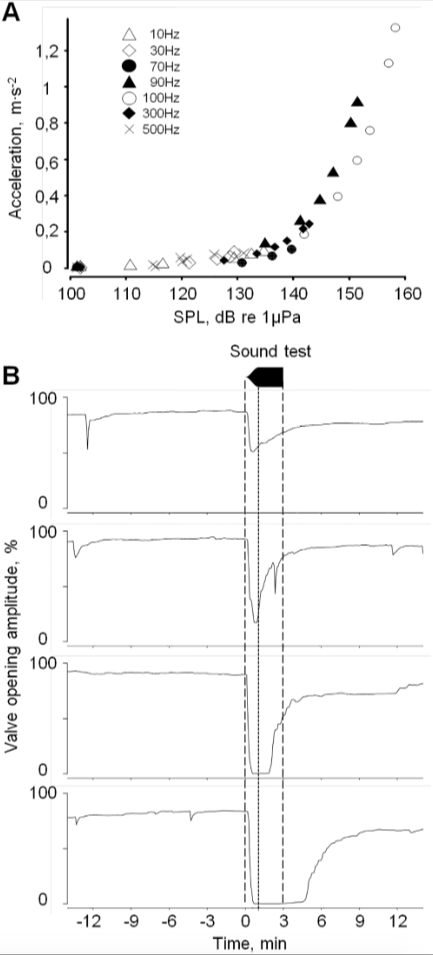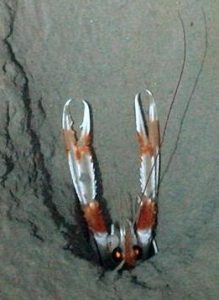Oysters and scallops: no ears, but they still hate loud ocean noises
Ocean, Seismic Surveys, Shipping Comments Off on Oysters and scallops: no ears, but they still hate loud ocean noises A recent line of research ups the ante on how widespread the impacts of human noise in the ocean may be. Oysters appear to suddenly and dramatically close up in response to low frequency noise at intensities that are relatively common—beginning at sound as levels as low as 120dB, and ramping up rapidly above 140dB. The figure at left shows how fast the shells closed at top and the degree of closing at bottom (from the minimal to maximal responses observed). Effects were strongest from 10-200Hz, a frequency range that includes shipping and seismic survey sounds.
A recent line of research ups the ante on how widespread the impacts of human noise in the ocean may be. Oysters appear to suddenly and dramatically close up in response to low frequency noise at intensities that are relatively common—beginning at sound as levels as low as 120dB, and ramping up rapidly above 140dB. The figure at left shows how fast the shells closed at top and the degree of closing at bottom (from the minimal to maximal responses observed). Effects were strongest from 10-200Hz, a frequency range that includes shipping and seismic survey sounds.
While oysters, like many other shellfish and crustaceans, do not have ears, they are sensitive to vibrations; earlier oyster studies speculate that they may be responding to subtle seabed vibrations, though it’s also possible their tissues are responding to water-borne particle motion. Another recent paper looked at scallop behavior and mortality after exposure to airguns, and reports that negative effects were seen for months after exposure:
“Exposure to seismic signals was found to significantly increase mortality, particularly over a chronic (months postexposure) time scale, though not beyond naturally occurring rates of mortality. Exposure did not elicit energetically expensive behaviors, but scallops showed significant changes in behavioral patterns during exposure, through a reduction in classic behaviors and demonstration of a nonclassic “flinch” response to air gun signals. … Hemolymph (blood analog) physiology showed a compromised capacity for homeostasis and potential immunodeficiency, … with effects observed over acute (hours to days) and chronic (months) scales. … Given the scope of physiological disruption, we conclude that seismic exposure can harm scallops.”
As our colleagues at Ocean Conservation stress in their coverage of these new developments, all this is part of a rapidly expanding awareness of the ways that our noise compromises ocean life far beyond the whales and dolphins that were the focus of initial concern and research. Early this year saw the publication of a comprehensive review of the potential impacts of marine seismic surveys on fish & invertebrates. The authors point out that on many topics (fish catch rates, startle responses, tissue damage) results have been mixed/contradictory, with some studies finding negative impacts and others finding no response; their paper lays out key areas for future research that could begin to clarify these ambiguities.
The authors of a 2016 study on the effects of shipping and construction noise on lobsters and clams paint the picture quite clearly:
Tim Leighton, Professor of Ultrasonics and Underwater Acoustics and study co-author, said: “There has been much discussion over the last decade of the extent to which whales, dolphins and fish stocks, might be disturbed by the sounds from shipping, windfarms and their construction, seismic exploration etc. However, one set of ocean denizens has until now been ignored, and unlike these other classes, they cannot easily move away from loud man-made sound sources. These are the bottom feeders, such as crabs, shellfish and invertebrates similar to the ones in our study, which are crucial to healthy and commercially successful oceans because they form the bottom of the food chain.” Co-author Dr Chris Hauton, Associate Professor in Invertebrate Ecophysiology and Immune Function, added: “I think these findings raise the prospect that anthropogenic sounds in the marine environment are impacting marine invertebrate species in ways that have not been previously anticipated.”
 The Leighton and Hauton study, using sound playbacks mimicking a ship at 100 yards and wind farm construction at 60 yards, found that both lobsters and clams changed their digging behaviors, and triggered changes in their overall activity level (lobsters increased, clams decreased); they found no marked effects on brittlestar activity.
The Leighton and Hauton study, using sound playbacks mimicking a ship at 100 yards and wind farm construction at 60 yards, found that both lobsters and clams changed their digging behaviors, and triggered changes in their overall activity level (lobsters increased, clams decreased); they found no marked effects on brittlestar activity.
Clearly, we are still in the early stages of understanding how our noises may be changing ocean ecosystems. In addition, the recent review paper affirms a longstanding concern that noise may act as a synergistic stressor, making animals more susceptible to other known stressors such as food shortages or rising ocean temperatures, noting that “Single stressors related to sound exposure may show no effects in isolation but when combined with other stressors effects may become pronounced.” New study designs are beginning to tease out these inter-relationships, giving researchers and ocean managers new tools that can move both science and policy forward in constructive ways.

 They look small, about the size of a “cherry bomb” firecracker. They’re legal, exempt from the Marine Mammal Protection Act thanks to their functional purpose: protecting fishermen’s nets from seals and cetaceans poaching their catches, including squid, anchovies, and tuna.
They look small, about the size of a “cherry bomb” firecracker. They’re legal, exempt from the Marine Mammal Protection Act thanks to their functional purpose: protecting fishermen’s nets from seals and cetaceans poaching their catches, including squid, anchovies, and tuna. Clark County SD is in a legal battle over its decision to increase wind turbine setbacks from 2000ft to 3960ft (three-quarters of a mile). The Clark County Commission approved the 400MW Crocker Wind Farm, but based on local experience with a smaller wind farm, decided that more distance was needed between turbines and non-participating homes. As reported by the Watertown Public Opinion:
Clark County SD is in a legal battle over its decision to increase wind turbine setbacks from 2000ft to 3960ft (three-quarters of a mile). The Clark County Commission approved the 400MW Crocker Wind Farm, but based on local experience with a smaller wind farm, decided that more distance was needed between turbines and non-participating homes. As reported by the Watertown Public Opinion: